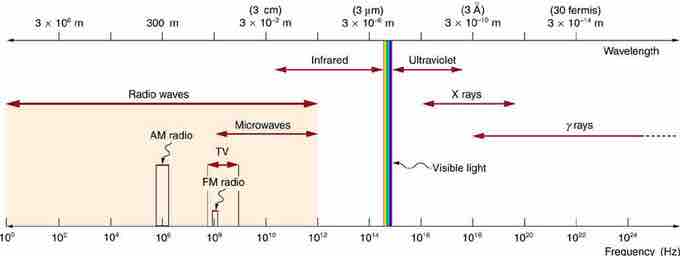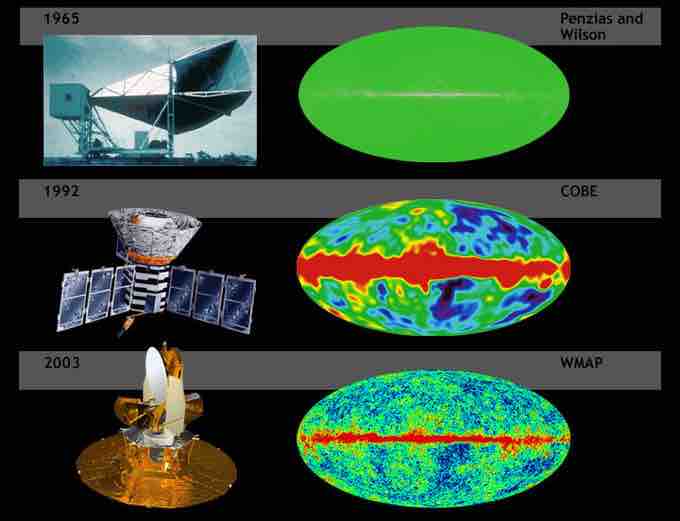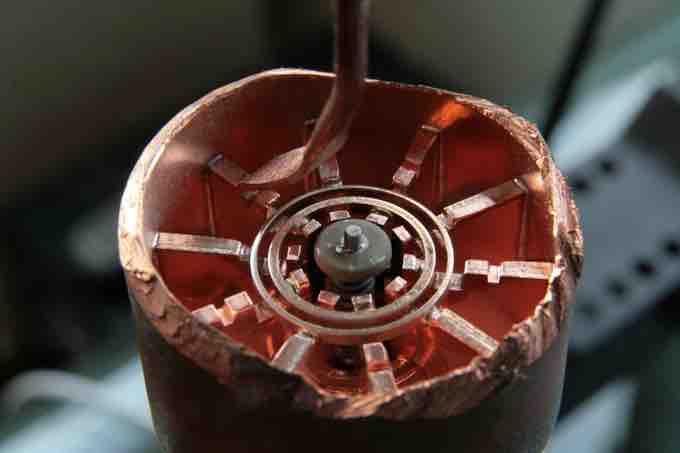Microwaves
Microwaves are electromagnetic waves with wavelengths ranging from as long as one meter to as short as one millimeter, or equivalently with frequencies between 300 MHz (0.3 GHz) and 300 GHz. The microwave region of the electromagnetic (EM) spectrum is generally considered to overlap with the highest frequency (shortest wavelength) radio waves. As is the case for all EM waves, microwaves travel in a vacuum at the speed of light. The prefix "micro-" in "microwave" is not meant to suggest a wavelength in the micrometer range. It indicates that microwaves are "small" because have shorter wavelengths as compared to waves used in typical radio broadcasting. The boundaries between far infrared light, terahertz radiation, microwaves, and ultra-high-frequency radio waves are fairly arbitrary. They are used variously between different fields of study (see figure).

Electromagnetic Spectrum
The electromagnetic spectrum, showing the major categories of electromagnetic waves. The range of frequencies and wavelengths is remarkable. The dividing line between some categories is distinct, whereas other categories overlap. Microwaves overlap with the high frequency portion of the radio section of the EM spectrum.
Subcategories of Microwaves
The microwave portion of the radio spectrum can be subdivided into three ranges, listed below from high to low frequencies.
- Extremely high frequency (EHF) is the highest microwave frequency band. EHF runs the range of frequencies from 30 to 300 gigahertz, above which electromagnetic radiation is considered as far infrared light, also referred to as terahertz radiation. This frequency range corresponds to a wavelength range of 10 to 1 millimeter, so it is sometimes called the millimeter band. This band is commonly used in radio astronomy and remote sensing.
- Super high frequency (SHF) is the designation for electromagnetic wave frequencies in the range of 3 GHz to 30 GHz. This band of frequencies is known also as the centimeter band because the wavelengths range from ten to one centimeters. This frequency range is used for most radar transmitters, microwave ovens, wireless LANs, cell phones, satellite communication, microwave radio relay links, and numerous short range terrestrial data links.
- Ultra-high frequency (UHF) designates the microwave frequency range of electromagnetic waves between 300 MHz and 3 GHz , also known as the decimeter band because the wavelengths range from one to ten decimeters, or 10 centimeters to 1 meter. They are used for television broadcasting, cordless phones, walkie-talkies, satellite communication, and numerous other applications.
Sources of Microwaves
Microwaves are the highest-frequency electromagnetic waves that can be produced by currents in macroscopic circuits and devices. Microwaves can also be produced by atoms and molecules—e.g., they are a component of electromagnetic radiation generated by thermal agitation. The thermal motion of atoms and molecules in any object at a temperature above absolute zero causes them to emit and absorb radiation.
Since it is possible to carry more information per unit time on high frequencies, microwaves are quite suitable for communications devices. Most satellite-transmitted information is carried on microwaves, as are land-based long-distance transmissions. A clear line of sight between transmitter and receiver is needed because of the short wavelengths involved.
The sun also emits microwave radiation, although most of it is blocked by Earth's atmosphere. The Cosmic Microwave Background Radiation (CMBR) is microwave radiation that permeates all of space, and its discovery supports the Big Bang theory of the origin of the universe.

Cosmic Microwave Background
Cosmic background radiation of the Big Bang mapped with increasing resolution.
Devices Employing Microwaves
High-power microwave sources use specialized vacuum tubes to generate microwaves. These devices operate on different principles from low-frequency vacuum tubes, using the ballistic motion of electrons in a vacuum under the influence of controlling electric or magnetic fields, and include the magnetron (used in microwave ovens), klystron, traveling-wave tube (TWT), and gyrotron.

Cavity Magnetron
Cutaway view inside a cavity magnetron as used in a microwave oven.
Microwaves are used by microwave ovens to heat food. Microwaves at a frequency of 2.45 GHz are produced by accelerating electrons. The microwaves then induce an alternating electric field in the oven. Water and some other constituents of food have a slightly negative charge at one end and a slightly positive charge at one end (called polar molecules). The range of microwave frequencies is specially selected so that the polar molecules, in trying to maintain their orientation with the electric field, absorb these energies and increase their temperatures—a process called dielectric heating.
Radar, first developed in World War II, is a common application of microwaves. By detecting and timing microwave echoes, radar systems can determine the distance to objects as diverse as clouds and aircraft. A Doppler shift in the radar echo can determine the speed of a car or the intensity of a rainstorm. Sophisticated radar systems can map the Earth and other planets, with a resolution limited by wavelength. The shorter the wavelength of any probe, the smaller the detail it is possible to observe.
A maser is a device similar to a laser, which amplifies light energy by stimulating photons. The maser, rather than amplifying visible light energy, amplifies the lower-frequency, longer-wavelength microwaves and radio frequency emissions.